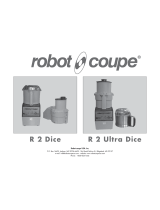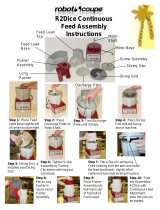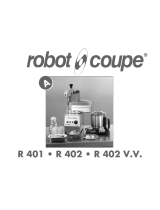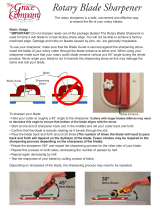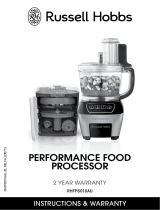Page is loading ...

P.O. Box 16625, Jackson, MS 39236-6625
280 South Perkins St., Ridgeland, MS 39157
e-mail: [email protected] - website: www.robotcoupeusa.com - Phone : 1-800-824-1646
R 2 Dicing R 2 Ultra Dicing

WARNING: In order to limit accidents such as electric shocks, personal injury or fire, and in order to limit material damage due to
misuse of the appliance, please read these instructions carefully and follow them strictly. Reading the operating instructions will
help you get to know your appliance and enable you to use the equipment correctly. The operation manual should be kept within
easy access to all users for reference and should be read completely by all first time users of the machine.
IMPORTANT WARNING
UNPACKING
• Carefully remove the equipment from the packa-
ging and take out all the boxes or packets contai-
ning attachments or specific items.
•WARNING-some of the parts are very sharp e. g.
blades, plates … etc.
INSTALLATION
•We recommend that you install your machine on
a stable solid base at a comfortable working height.
CONNECTION
•Always check that your power supply corres-
ponds to that indicated on the serial number plate
and that it is properly sized.
HANDLING
• Always wear cut-resistant gloves when handling
the cutting plates or the cutter blade.
ASSEMBLY PROCEDURES
• Follow the various assembly procedures carefully
(see page 6) and make sure that all the attachments
are correctly positioned.
USE
•Do not open the feed lead / attachment until
the motor has come to a complete stop.
• Never tamper with, or defeat the purpose of
the locking and safety systems.
• Do not put nonfood objects in the bowl or
vegetable prep openings.
• Always use the food pushers to push the product
into the vegetable preparation attachment openings.
• Do not leave the machine running unattended.
CLEANING
•Always unplug your machine before cleaning.
• Always clean the machine and attachments at
the end of each use.
• Never place the motor unit in water.
• For parts made of aluminum alloys, use
cleaning detergents suitable for aluminum.
• For plastic parts, do not use detergents that are
too alkaline (i.e., containing too much caustic soda
or ammonia…).
Robot Coupe can in no way be held responsible
for the user’s failure to follow the basic rules of
cleaning and maintenance.
MAINTENANCE
• Always unplug the appliance before servicing.
• Check the seals regularly and ensure that the
safety devices are in good working order.
• It is particularly important to maintain and
check the attachments since certain products
contain corrosive agents e.g. citric acid.
• NOTICE
: Never operate the appliance if the
power cord or plug has been damaged.
• If the machine fails to operate as described in
this manual, or if the machine malfunctions in any
way, remove the machine from use and have it
serviced. Additionally, discard all food processed
at the time of the malfunction.
• Contact your local ROBOT-COUPE Authorized
Service Agency if something appears to be wrong.
KEEP THESE INSTRUCTIONS
IN A SAFE PLACE
WARNING

1
ENGLISH
FRANÇAIS
ESPAÑOL
OPERATING INSTRUCTIONS
MANUAL DE INSTRUCCIÓN
NOTICE D’INSTRUCTION
We reserve the right to alter at any time without notice the technical specifications of this appliance. None of the information
contained in this document is of a contractual nature. Modifications may be made at any time.
© All rights reserved for all countries by: ROBOT-COUPE s.n.c.
Nos reservamos el derecho de modificar en todo momento y sin previo aviso las características técnicas de este aparato.
Las informaciones que figuran en este documento no son contractuales y pueden ser modificadas en todo momento.
© Todos los derechos reservados para todos los países por : ROBOT-COUPE s.n.c.
Nous nous réservons le droit de modifier à tous moments et sans préavis les caractéristiques techniques de cet appareil.
Les informations figurant dans ce document ne sont pas contractuelles et peuvent être modifiées à tout moment.
© Tous droits réservés pour tous pays par : Robot-Coupe s.n.c.

3
ENGLISH
3
SUMMARY
WARRANTY
IMPORTANT WARNING
INTRODUCTION TO YOUR NEW
R 2 Dicing • R 2 Ultra Dicing
BOWL CUTTER/ VEGETABLE PREPARATION
SWITCHING ON THE MACHINE
• Advice on electrical connections
• Control panel
ASSEMBLY
• Bowl attachment
• Vegetable preparation attachment
OPERATING INSTRUCTIONS
• Bowl attachment
• Vegetable preparation attachment
CLEANING
• Motor base
• Attachments
MAINTENANCE
• Motor seal
• Blade
• Bowl locking bushings
SAFETY
WIRING DIAGRAM
(page 27)

4
THE FOLLOWING ARE NOT
COVERED BY THE ROBOT COUPE
U.S.A. INC LIMITED WARRANTY:
1 -
Damage caused by abuse, misuse, drop-
ping, or other similar damage caused by
or resulting from failure to follow assembly, ope-
rating, cleaning, user maintenance or storage
instructions.
2 - Labor to sharpen and/or replacements for
blades that have become blunt, chipped or worn
after a normal or excessive period of use.
3 - Materials or labor to replace or repair
scratched, stained, chipped, pitted, dented or
discolored surfaces, blades, knives, attachments
or accessories.
4 - Any alteration, addition, or repair that has
not been carried out by the company or an ap-
proved service agency.
5 - Transportation of the appliance to or from
an approved service agency.
6 - Labor charges to install or test new
attachments or accessories (i.e., bowls, plates,
blades, attachments), which have been replaced
for any reason.
7 - The cost of changing direction-of-rotation
of three-phase electric motors (Installer is
responsible).
8 - SHIPPING DAMAGES. Visible and/or
hidden damage is the responsibility of the freight
carrier. The consignee must inform the carrier
and consignor immediately, or upon discovery in
the case of hidden defects.
KEEP ALL ORIGINAL CONTAINERS AND PAC-
KING MATERIALS FOR CARRIER INSPECTION.
Neither ROBOT COUPE U.S.A., INC. nor its
affiliated companies or any of its distributors, di-
rectors, agents, employees, or insurers will be
liable for indirect damage, losses, or expenses
linked to the appliance or the inability to use it.
The ROBOT COUPE U.S.A., INC. warranty
is given expressly and in lieu of all other
warranties, expressed or implied, for merchan-
tability and for fitness toward a particular
purpose and constitutes the only warranty
made by ROBOT COUPE U.S.A., INC..
YOUR NEW ROBOT COUPE
PRODUCT IS WARRANTED TO THE
ORIGINAL PURCHASER FOR A
PERIOD OF ONE YEAR FROM THE
DATE OF PURCHASE.
This LIMITED WARRANTY is against
defects in the material and/or
workmanship, and includes labor for
replacement of defective parts,
provided repairs are performed by
an authorized service agency (see
attached list).
The Customer must inform the
Service Agency of the possibility of
warranty coverage and provide a
copy of the dated sales or delivery
receipt BEFORE WARRANTY REPAIRS
ARE BEGUN.
Replacement parts and accessories
are warranted for ninety (90) days
from the date of purchase when
purchased separately and will be
verified by dated sales receipt OR
packing slip which lists that item.
All parts or accessories replaced
under warranty must be returned to
the Service Agency.
ROBOT COUPE U.S.A., INC. LIMITED WARRANTY

5
ENGLISH
WARNING: In order to limit accidents such as electric shocks, personal injury or fire, and in order to limit material damage due to
misuse of the appliance, please read these instructions carefully and follow them strictly. Reading the operating instructions will
help you get to know your appliance and enable you to use the equipment correctly. The operation manual should be kept within
easy access to all users for reference and should be read completely by all first time users of the machine.
IMPORTANT WARNING
UNPACKING
• Carefully remove the equipment from the packa-
ging and take out all the boxes or packets contai-
ning attachments or specific items.
•WARNING-some of the parts are very sharp e. g.
blades, plates … etc.
INSTALLATION
•We recommend that you install your machine on
a stable solid base at a comfortable working height.
CONNECTION
•Always check that your power supply corres-
ponds to that indicated on the serial number plate
and that it is properly sized.
HANDLING
• Always wear cut-resistant gloves when handling
the cutting plates or the cutter blade.
ASSEMBLY PROCEDURES
• Follow the various assembly procedures carefully
(see page 6) and make sure that all the attachments
are correctly positioned.
USE
•Do not open the feed lead / attachment until
the motor has come to a complete stop.
• Never tamper with, or defeat the purpose of
the locking and safety systems.
• Do not put nonfood objects in the bowl or
vegetable prep openings.
• Always use the food pushers to push the product
into the vegetable preparation attachment openings.
• Do not leave the machine running unattended.
CLEANING
•Always unplug your machine before cleaning.
• Always clean the machine and attachments at
the end of each use.
• Never place the motor unit in water.
• For parts made of aluminum alloys, use
cleaning detergents suitable for aluminum.
• For plastic parts, do not use detergents that are
too alkaline (i.e., containing too much caustic soda
or ammonia…).
Robot Coupe can in no way be held responsible
for the user’s failure to follow the basic rules of
cleaning and maintenance.
MAINTENANCE
• Always unplug the appliance before servicing.
• Check the seals regularly and ensure that the
safety devices are in good working order.
• It is particularly important to maintain and
check the attachments since certain products
contain corrosive agents e.g. citric acid.
• NOTICE
: Never operate the appliance if the
power cord or plug has been damaged.
• If the machine fails to operate as described in
this manual, or if the machine malfunctions in any
way, remove the machine from use and have it
serviced. Additionally, discard all food processed
at the time of the malfunction.
• Contact your local ROBOT-COUPE Authorized
Service Agency if something appears to be wrong.
KEEP THESE INSTRUCTIONS
IN A SAFE PLACE
WARNING

• CONTROL PANEL
R 2 Dicing / R 2 Ultra Dicing
Red knob = Off switch
Green knob = On switch
Black knob = Pulse control
ASSEMBLY
• BOWL ATTACHMENT
1) With the motor base
facing you, place the
bowl onto the motor
base with the handle
toward the front. Turn
the bowl just off-center
and to the left as you
lower it onto the base.
2) Then, turn it back to
the right, (counterclock-
wise) locking it onto the
motor base tabs.
6
INTRODUCTION TO YOUR NEW
R 2 Dicing • R 2 Ultra Dicing
The R 2 Dicing / R 2 Ultra Dicing is a versatile
machine designed to meet your professional needs.
It can perform a number of tasks, as well as save
much in time and labor.
This food processor consists of a bowl assembly and
a vegetable preparation attachment. The 3 quart
bowl is used for chopping, grinding, pureeing,
blending, mixing, and kneading ingredients used in
most recipes.
A wide range of cutting plates are available for use
with the vegetable preparation attachment. Cutting
plates are available for slicing, waved slicing,
grating, pulping, julienne and dicing.
Its numerous functions will open the door to a whole
new culinary world.
Thanks to its simple design, all components
requiring frequent handling for maintenance or
cleaning can be easily assembled or removed.
All users should read this operation manual before
operating the machine.
SWITCHING ON
THE MACHINE
•ADVICE ON ELECTRICAL CONNECTIONS
Before plugging in, check that your power supply
corresponds to that indicated on the machine’s
serial number plate.
3) Place the blade onto
the motor shaft. Rotate
the blade until it drops
into place. The bottom
blade should be level
with and just off the
bottom of the bowl.
4) Note the plastic tab
on the bowl lid. Place
the lid on the bowl with
the tab turned to the
front and slightly to the
left of the bowl handle;
then, turn the lid back to
the right until it comes to
a stop with the tab over
the bowl handle.
The device is now ready for use.
• VEGETABLE PREPARATION ATTACHMENT
The vegetable preparation attachment consists of
two main detachable parts: the continuous feed
attachment and the continuous feed lead.
1) With the motor base
facing you, fit the conti-
nuous feed attachment
onto the motor base; the
exit chute should be at
the rear of the machine.
This appliance must be plugged into a
grounded socket (risk of electrocution).
W ARNING

7
ENGLISH
4b) Next place the ap-
propriate dicing plate
onto the discharge plate
and screw the butterfly
nut tight on the motor
shaft.
To dice carrots or hard
vegetables, we advise
you to use the small
cylindrical opening.
5) Place the continuous
feed lead onto the conti-
nuous feed attachment,
and rotate it back to the
right until it locks onto
the bowl tabs.
OPERATING
INSTRUCTIONS
• THE UNIT SHOULD BE OFF EXCEPT WHEN
PROCESSING IS UNDERWAY
It is recommended that the machine be operated
on a 50 % duty cycle. This is easily accomplished
since the preparation time (cleaning, coring,
peeling, and loading) takes longer than the
processing time. This will yield the longest life for
your machine.
• BOWL ATTACHMENT
The cutter bowl is used for grinding, kneading,
pureeing, blending, mixing, and emulsifying.
Before placing the product into the bowl, some
products such as meats and cheeses should be
precut into 1-2 inch portions. When filling
the bowl, allow space above the product for
circulation.
There are two ways to run your machine :
chopping, using a quick start/stop action with
the Pulse button or running continuously for a fine
chop or puree. To obtain a uniform chop of
products such as meats and cheeses, begin with a
uniformly portioned product. Pulse the machine
until the desired result is reached. Then, if a puree
or fine chop is desired, press the On button, and
allow the machine to run until the product has the
right consistency.
USING A DICING ASSEMBLY :
4a) If you have chosen to dice, position the dicing
grid in the continuous feed attachment.
The grid can be positionned in only one way. The
blades should be visible trough the feed lead opening.
2) Turn the attachment to
the right until it locks onto
the motor base tabs.
3) Place the discharge
plate onto the motor
shaft. It should fall into
place just off the bottom
of the continuous feed
attachment.
USING A REGULAR PLATE :
4) Place the cutting plate
of your choice onto the
discharge plate. It may
be necessary to rotate
the plate until it drops
fully onto the discharge
plate.
Follow step 5.

8
• VEGETABLE PREPARATION ATTACHMENT
The vegetable preparation attachment is used for
slicing, grating, waved slicing, julienne, pulping
and dicing.
The vegetable preparation attachment consists of
two feed openings :
- one large feed opening for cutting vegetables
such as cabbage, celeriac, etc.
- a cylindrical feed opening inside the large
pusher for long or hard vegetables and high-
precision cutting.
For optimum cutting, use this section as a guide.
Do not attempt to run frozen products through the
cutting plates.
Do not put anything other than food products into
the feed openings.
Do not remove attachments while the motor is
running.
Do not apply excess pressure to the food pushers :
This can cause damage to the motor and other
parts.
HOW TO USE THE LARGE FEED OPENING
Fill the hopper with the foodstuff. Apply the pusher
on the food with a constant and moderate pressure.
Press the On button to start the motor. To get the
best quality cut, maintain a moderate pressure on
the pusher until the full hopper is processed.
HOW TO USE THE CYLINDRICAL SMALL OPENING
Remove the small pusher from the large pusher. Fill
the small opening with the foodstuff and follow the
same procedure as above.
CLEANING
W ARNING
3
/
8”
cabbage / cheese
Hard cheese
1
/
32”
Extra fine 0.7mm
3
/
64”
Pulping 1 mm
SLICERS
3
/
64”
carrot / cabbage / cucumber / onion / potato / leek
5
/
64”
-
1
/
8”
lemon / carrot / mushroom / cabbage / potato / cucumber /
zucchini / onion / leek / bell pepper
5
/
32”
-
3
/
16”
eggplant / beet root / carrot / mushroom / cucumber /
bell pepper /radish / lettuce / potato / leek / tomato
1
/
4”
eggplant / beet root / carrot / mushroom / cucumber /
bell pepper /radish / lettuce / potato / leek
RIPPLE CUT SLICER
5
/
64”
beet root / potato
GRATERS
1
/
16”
celeriac / cheese
5
/
64”
carrot / celeriac / cheese
1
/
8”
carrot
1
/
4”
cabbage / cheese
JULIENNE
5
/
64”
x
5
/
64”
carrot / celeriac / potato
5
/
64”
x
5
/
32”
carrot / beet root / zucchini / potato
5
/
64”
x
1
/
4”
carrot / beet root / zucchini / potato
5
/
32”
x
5
/
32”
eggplant / beet root / zucchini / potato
1
/
4”
x
1
/
4”
eggplant / beet root / celeriac / zucchini / potato
5
/
16”
x
5
/
16”
celeriac / potato
DICE
5
/
16”
x
5
/
16”
potato / carrot / zucchini / beet root / turnip
3
/
8”
x
3
/
8”
potato / carrot / zucchini / beet root / turnip
7
/
16”
x
7
/
16”
potato / carrot / zucchini / beet root / turnip
As a precaution, always unplug your
appliance before cleaning it (risk of electric
shock).
Max.
USES
processing
Processing
quantity
time
(in pounds)
(in mn)
CHOP
• MEAT
Hamburgers / steak tartare 2 3
Sausagemeat / tomatoes 2 3
Terrine / pâté 2 4
• FISH
Brandade 2 5
Terrines 2 5
• VEGETABLES
Garlic / parsley /onion / shallots
3
/
4
3
Soup / purées 2 4
• FRUIT
Compotes /purées 2 4
EMULSIFY
Mayonnaise / ailloli /
remoulade sauce
2
1
/
4
3
Hollandaise / béarnaise 2
1
/
4
5
Snail or salmon butter 2
1
/
4
4
KNEAD
Shortcrust pastry / shortbread 2 4
Flaky pastry 2 4
Pizza dough 2 4
GRIND
Dried fruit 1 4
Parsley 1 4
Breadcrumbs 1 4

9
ENGLISH
Autoclave:
The blade assembly will withstand cleaning in an
autoclave system with temperatures less than
210 degrees C. However, it will reduce the life of
the blade as compared to the following cleaning
instructions.
Remove all attachments befor
e cleaning. The bowl
and continuous feed assemblies should be cleaned
per the following instructions or as required by local
health department regulations.
The bowl, blade, lid, continuous feed bowl,
continuous feed lead, pushers, and plates are
dishwasher safe. All of the attachments listed above
can be washed in a dish machine or three-tank
system pot sink. Pre-rinse the attachments before
washing to remove any bulk food on the parts.
A stiff bristle brush or power sprayer faucet
attachment is effective in knocking the food out of
the crevices as a pre-rinse procedure. The washer
should have an industry standard wash, rinse, and
sanitization cycle. Allow the parts to air dry after
sanitizing and before reassembly.
NOTE : The high temperatures of dish machines will
tend to shorten the life of the plastic and rubber
parts. Hand washing using a three-pot sink will
provide for the longest life of these parts.
Wear cut-resistant gloves when cleaning the blade
and plates.
Inpect the area on the outside of the bowl around
the handle and the outside of the continous feed
bowl around the interlock pin to ensure they are
clean. Use a brush on these areas if necessary.
• MOTOR BASE
Never immerse the motor base in water. Clean
using a damp cloth or sponge.
Cleaning of the motor base assembly must be done
with care.
First unplug the unit. A sponging with a cloth lightly
dampened (not dripping) in a mild detergent is
acceptable, making sure the water is not permitted
to penetrate the shaft seal or around the switches
and in the ventilation openings. Clean around the
shaft seal with a small brush, taking care to remove
all food. Do not forget to clean the motor shaft.
Rinse the motor base first using a cloth lightly
dampened (not dripping) with water, then with a
sanitizing solution. Dry the machine with a soft cloth
removing all liquids from seal areas.
• ATTACHMENTS :
CLEANING THE BLADE ASSEMBLY
There is a removable cap
attached to the top of the
S-blade assembly. This
cap should be removed
before cleaning the blade
assembly.
Caution: The blades are sharp. Wear cut-resistant
gloves when handling the blade.
The blade cap may be removed by carefully pulling
the cap up away from the blade. It may be helpful
to pull slightly to the side. The cap is held in place
by small plastic clips that snap into the body of the
blade assembly. If the cap is difficult to remove, you
can use a small diameter rod or screwdriver inserted
through the bottom side of the blade assembly to
knock out the cap using a quick sharp impact.
Again, use caution when handling the blade.
IMPORTANT
MAINTENANCE
• MOTOR SEAL
An examination should be made periodically to
ensure that a seal against liquids is being
maintained around the motor shaft. The seal can
and should be replaced whenever wear or erosion
is noted or minimally once every three to six
months. It is recommended that the seal be replaced
by an authorized repair agency.
• BLADE
Blades should be kept sharp. It is not necessary
to have a razor edge. However, they will need
sharpening periodically. Replacement of the dull
blades or plates is recommended.
SHARPENING THE BLADE
The blade will require
sharpening on a perio-
dic basis depending on
use. The use of a dull
blade will sometimes
give unsatisfactory
results. Follow the
directions shown to
sharpen the blade, or
have the blades shar-
pened professionally if you prefer.
- Put on your cut-resistant gloves
- Use a Robot Coupe stone or any good sharpening
stone.
- Hold or clamp the blade flat on the edge or corner
of a sturdy table.
- With the other hand, hold the stone at a 30 degree
angle against the top bevel of one blade.
- Pull the stone into the blade edge moving from hub
to tip, several strokes, until the blade is sharp.
Check that your detergent is suitable for
cleaning plastic parts. Some washing agents
are too alkaline (e.g. high levels of caustic
soda or ammonia) and totally incompatible
with certain types of plastic, causing them to
deteriorate rapidly.

10
W ARNING
REMEMBER
- Turn the blade over, and rub the stone flat against
the underside of the blade to remove the feather
edge formed at step 5.
- Repeat the procedure for the other blade.
- Wash the blade before use.
•BOWL LOCKING BUSHINGS (R2 Ultra Dicing)
If these bushings wear out, the bowl will no longer
be securely attached to the motor base.
Replacement bushings can be ordered: part number
R289.
SAFETY
The R 2 Dicing/R 2 Ultra Dicing are fitted with an
interlock system.
When you open the bowl lid, the motor stops.
When you open the continuous feed lead, the motor
stops.
Never try to override or defeat the purpose
of, the locking and safety systems.
Never put nonfood objects into the machine
openings.
Only use the food pushers to force the food
into the machine.
Do not overload the appliance.
Never leave the machine running unattended.
The blades and cutting plates are extremely
sharp. Handle with care.
To avoid splashing when running liquids in the
bowl, allow the blades to come to a complete stop
before opening the lid.
NOTE : The machines are equipped with a thermal
protector which automatically stops the motor if the
machine is overloaded. If this happens, press
the Off button and allow the machine to cool
completely before restarting.

27
WIRING DIAGRAM
DATOS TÉCNICOS
DONNÉES TECHNIQUES

28

29

30

31

33

Réf. : 450 159 - 03/2004 - R 2 Dicing • R 2 Ultra Dicing - USA
P.O. Box 16625, Jackson, MS 39236-6625
280 South Perkins St., Ridgeland, MS 39157
e-mail: [email protected]
website: www.robotcoupeusa.com
Phone : 1-800-824-1646
/
